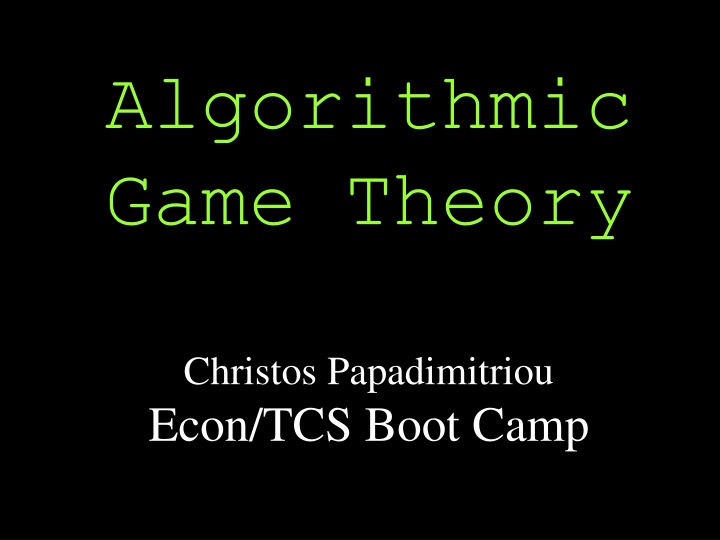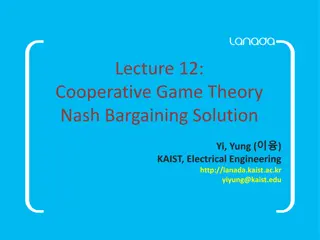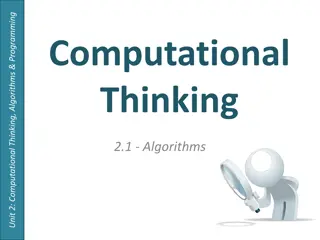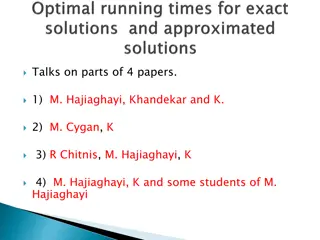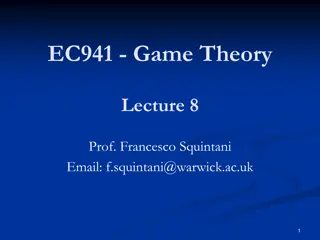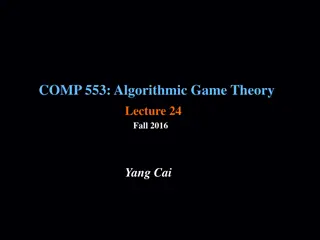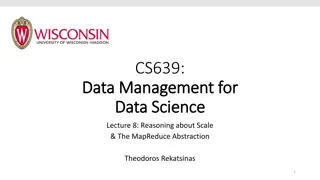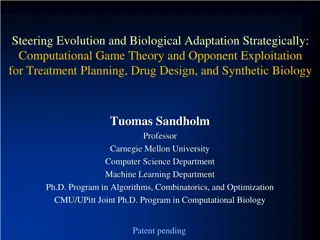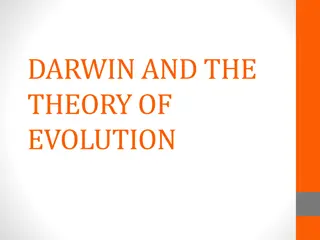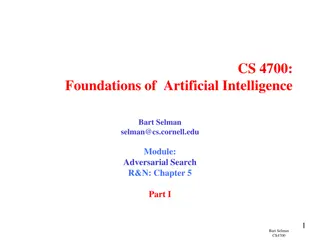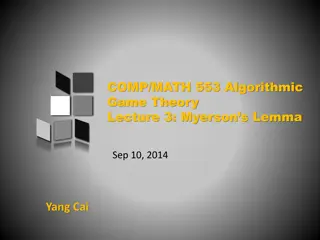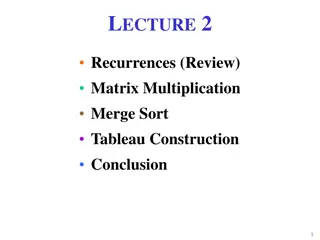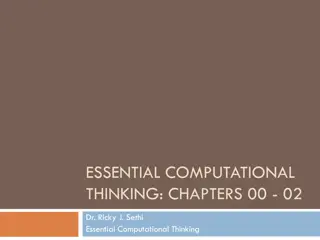Evolution of Algorithmic Game Theory in Computer Science
The evolution of Algorithmic Game Theory (AGT) in the realm of Computer Science showcases the intersection of economics and theoretical computation. Before 1995, notable researchers like von Neumann and Megiddo laid the foundation for AGT. Concepts such as computation as a game, bounded rationality, and complexity in cooperative games emerged, leading to advancements in understanding solution concepts and Nash equilibrium. The advent of the Internet transformed Computer Science into a physical and social science, revolutionizing the field.
Download Presentation

Please find below an Image/Link to download the presentation.
The content on the website is provided AS IS for your information and personal use only. It may not be sold, licensed, or shared on other websites without obtaining consent from the author.If you encounter any issues during the download, it is possible that the publisher has removed the file from their server.
You are allowed to download the files provided on this website for personal or commercial use, subject to the condition that they are used lawfully. All files are the property of their respective owners.
The content on the website is provided AS IS for your information and personal use only. It may not be sold, licensed, or shared on other websites without obtaining consent from the author.
E N D
Presentation Transcript
Algorithmic Game Theory Christos Papadimitriou Econ/TCS Boot Camp
Before 1995 A few researchers did both: von Neumann N. Megiddo R. E. Stearns
Btw: TCS = Theoretical Computer Science = The mathematical study of computation and in particular of algorithms and their complexity
Also before 1995: Computation as a game Yao s Lemma (1977) Alternation formulation of space (ca. 1980) Erenfeucht Fra ss games (ca. 1955) Resource allocation in computer systems through market mechanisms (1980s-90s)
Bounded Rationality Herbert A. Simon (1972): Are undesired equilibria often the result of the common assumption that agents have unbounded resources for reasoning? Megiddo and Wigderson (1986) P. (GEB 1992) P. and Yannakakis (1994 STOC) Fortnow and Kimmel (1994 STOC)
Complexity in Cooperative Games How hard is it to compute solution concepts such as the core, the Shapley value, the vN-M solution, the nucleolus, etc. in a particular cooperative game Deng and P. (1990)
About the same time: complexity of Nash equilibrium? Megiddo and P. 1991 Nonconstructive proofs and TFNP Also, Koller, Megiddo, von Stengel (1994) algorithms for extensive-form zero-sum games
Then, all of a sudden the Internet happened!
The Internet changed Computer Science (and TCS) it turned it into a physical science
The Internet changed Computer Science (and TCS) it turned it into a physical science and a social science
Also, the methodological path to AGT: TCS as a Lens
The Internet is an equilibrium; we just need to identify the game Scott Shenker
Remember Max? Max = a[1] for i= 2, ,n do if a[i] > Max, Max = a[i] VCG is the new Max!
Algorithmic Mechanism Design? Joel Sobel (ca 1990) Mechanism designers get away with too many positive results. Aren t there complexity obstacles?
Algorithmic Mechanism Design! Nisan and Ronen (1998): Combinatorial auctions! Juggling: fast computation vs close approximation vs incentive compatibility
What makes a scientific idea go viral?
Much more on this in Jason s and Costis s talks
The new Complexity Theory Let PICbe the class of all oprimization problems that can be solved in polynomial time in an incentive compatible way PIC = P (reason: VCG) NP-completeIC = NP-complete APXIC APX (assuming P NP) (Shapira, Singer, P. 2009)
Meanwhile: Equilibria can be inefficient! delays social optimum: 1.5 x 1 0 equilibrium: 2 x 1
Measuring the inefficiency: The price of anarchy cost of worst Nash equilibrium p. of A = optimum social cost (Koutsoupias and P. 1999) 21
Equilibria can be inefficient delays x 1 social optimum: 1.5 0 x 1 equilibrium: 2 (so, p. of A 4/3)
How much worse does it get? = 4/3 !!! p. of A [Roughgarden and Tardos, 2000; Roughgarden 2002] 23
But in the Internet flows don t choose routes (P. and Greg Valiant, 2010): Suppose that each node routes the flow through it in such a way as to minimize expected travel time Price of anarchy can be unbounded But if routers charge a price per flow for routing (and compete for flows) then the price of anarchy vanishes
why wasnt the price of anarchy studied before?
Complexity of Equilibria The existence proofs for equilibria usually rely on topological theorems that are not constructive Can we find the equilibria in reasonable time? Or is this an intractable problem?
Nash is Intractable Finding a Nash equilibrium is intractable Specifically, PPAD-complete (Daskalakis, Goldberg, P. 2006) Even for 2 players (Chen, Deng 2006)
PPA what? unbalanced node Where is the other unbalanced node??
Imagine now that the graph is exponential, and the edges are given by an algorithm Now how can you find the other unbalanced node? It seems to take exponential time, huh? That s PPAD-complete If it can be solved, cryptography is impossible
But why should we care about intractability?
The Nash equilibrium lies at the foundations of modern economic thought Nobody would take seriously a solution concept that is not universal Roger Myerson
Price equilibria Recall the Arrow-Debreu theory: producers, consumers, production functions, utilities Convexity prices Prices Pareto efficiency
Intractability Finding price equilibria in exchange economies with consumer utilities that are just outside gross substitutablity is PPAD-complete (Chen, Paparas, Yannakakis 2013)
More intractability (price adjustment mechanisms) For any price adjustment mechanism there is an exchange market with three goods such that it takes the mechanism 21/ steps to achieve excess demand (P. Yannakakis 2013)
Price equilibria in economies with production input Convexity = no economies of scale output How do you get Pareto efficiency when you have economies of scale?
Complexity equilibria With economies of scale, there are situations (a dense set thereof) where all agents can improve a lot, but they are all stuck at an inefficient place, and it is worse than NP- complete to get unstuck (P. and Chris Wilkens, 2011)
Exact equilibria? So far, we have been discussing approximate equilibria: excess demand, or incentive to deviate, is very small These may not be close to true equilibria Exact equilibria are much harder to find, possibly not in NP (the class FIXP) (Etessami and Yannakakis 2010)
Three nice triess to deal with Nash equilibria Lemke-Howson algorithm The Homotopy Method The Harsanyi Selten equilibrium selection method
Much harder! It is PSPACE-complete to find the Nash equilibrium arrived at by (a) the Lemke-Howson algorithm; (b) the homotopy method; and (c) the Harsanyi-Selten equilibrium selection method (Goldberg, Papadimitriou, Savani, 2010)
Soooooo The prehistory of AGT AGT s two decades Algorithmic Mechanism Design The Price of Anarchy Equilibria and Complexity
And there is so much more Algorithmic Social Choice Algorithmic market design Prediction makets and matching markets Cooperative games Incentives in social networks Security and privacy Crowdsourcing
Next: some current stuff and some forward-looking stuff Back to our roots: AGT and the Internet Update on Approximate Nash AGT and Social Networks [ AGT and the Theory of Evolution ] [ Dynamic mechanism design ] AGT and Dynamical Systems AGT and data
Update on Approximate Nash LSS: For Nash only PTAS makes sense Why? The curse of easy best response Is there a PTAS? or PPAD-completeness for > 0? [Rubinstein 2015]: The latter!! (For n-player games )
But how about 2 or 3 players? Can we extend Aviad s result? [LMM 2003]: QPTAS So, it is probably not PPAD-complete
Can almost everybody be almost happy? ( , ) NASH: Given an n-player game, find a strategy profile such that a (1 ) fraction of the players are within of best response Note: this is PPAD-complete for = 0 and some > 0.
Can almost everybody be almost happy? Theorem: If for some , > 0 ( , ) NASH requires 2n time or even 2 ( n) time then [LMM 2003] is the best possible (Babichenko, P, Rubinstein 2015) A PCP for PPAD
Classification when the data are strategic (Joint work with Hardt, Megiddo, Wootters) Fact: The number of books in the household is an excellent predictor of success at school actually, a bit better than grades So, an admissions classifier should use this
Problem: classifier grades books
